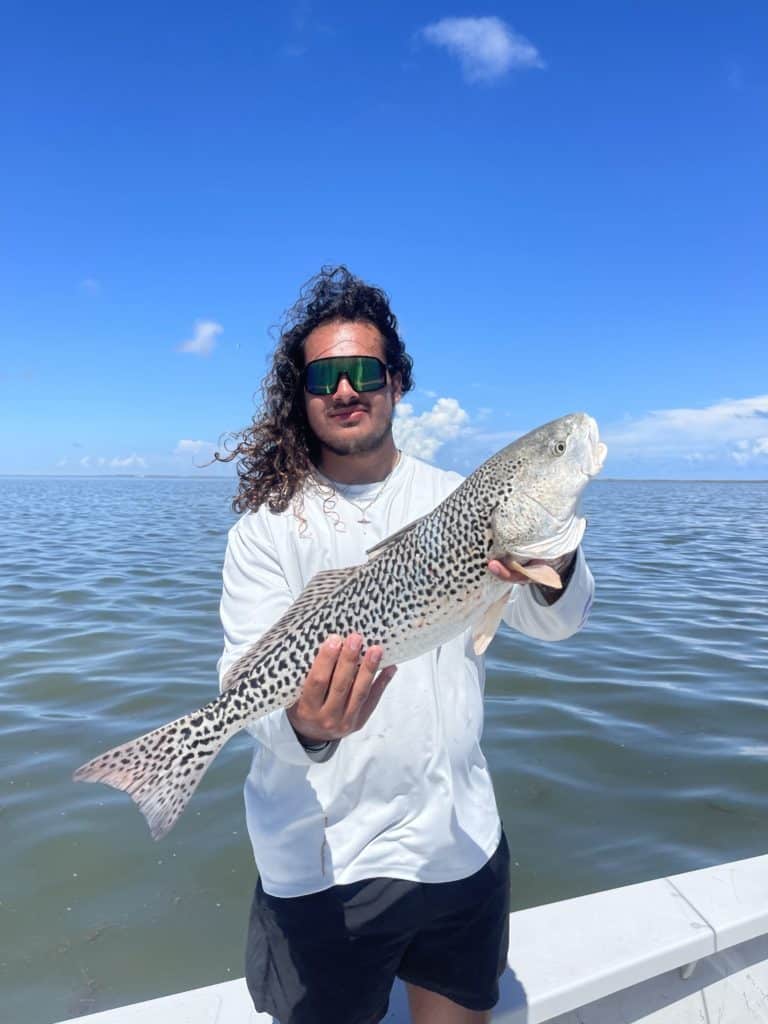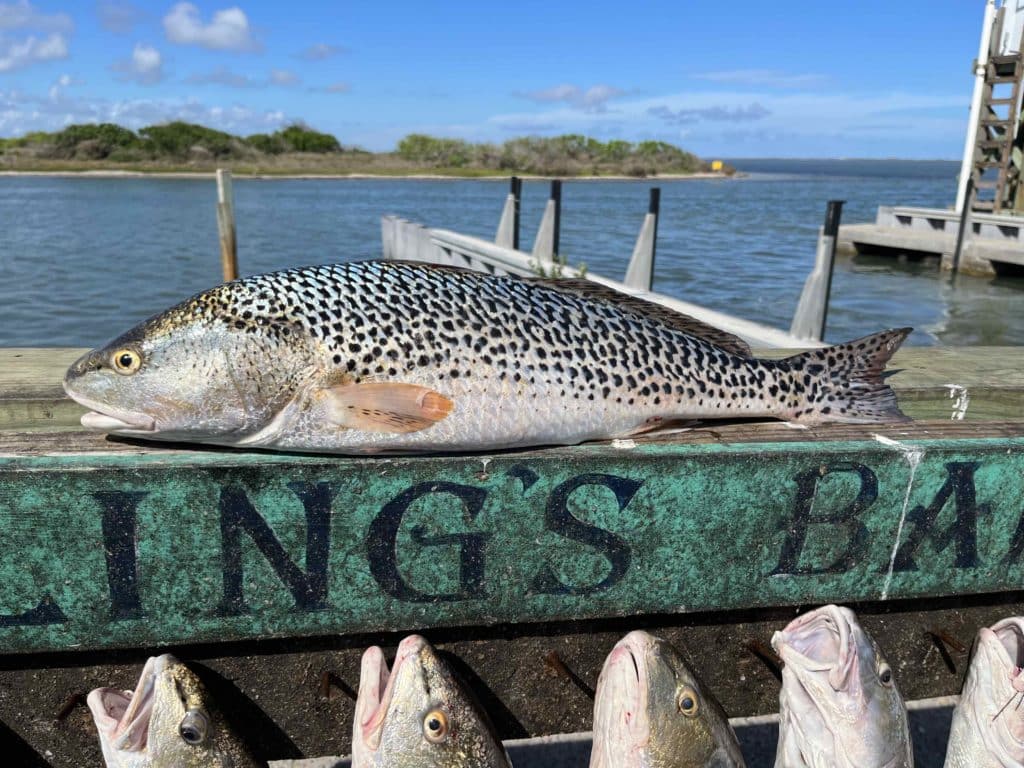
Capt. Danny Alvarez has been fishing since he returned home from military service about a half a century ago. He has spent much of that time guiding charter anglers to flounder, black drum, speckled trout and redfish (red drum) in the productive coastal waters around Corpus Christi, Texas. But in all those years he’s never once laid eyes on a rare leopard redfish outside the pages of a fishing magazine—until Aug. 27, when Alvarez hosted his son, Eric, and several of their in-laws on an outing on Laguna Madre near Baffin Bay.
After helping them catch their fill of trout, Alvarez took the extended family to an area where he’d been having good luck with that iconic quarry of Gulf Coast angling: big redfish.
“This time of year usually the big bull reds are starting to run a little bit more,” Alvarez told Salt Water Sportsman. “They gather up in schools and I’ve been doing real well catching good-size keepers and oversized reds,” he says. The slot limit on that stretch of coast allows anglers to keep redfish from 20 to 28 inches long.
The captain had everyone throwing bottom rigs baited with ladyfish chunks into sand pockets along grass lines in 2 to 3 feet of water. A young angler named Ryan Hernandez, the boyfriend of one of Alvarez’s in-laws, was fishing with a brand-new Waterloo Phantom spinning rod he’d just bought. Hernandez hooked a good fish, but after taking one glance at it Alvarez gave him some tough news.
A Redfish With as Many Spots as a Seatrout
“When I first saw it, from 15 or 20 yards out, I saw all the specks and it looked like a big trout,” Alvarez recounts. “I said, ‘Man, that’s a good trout. But we’re probably going to end up releasing it, because it’s probably over 23 inches,’” the upper end of the trout slot.
“He kept on fighting it, and he kept on taking line,” Alvarez says, “and once it got closer I said, ‘Aw, that ain’t no trout: That’s a redfish.’”
When they netted the fish and brought it into the boat, “everybody was excited to see it,” he says. “When we first got it out of the water, it had a real shiny color to the skin, like a turquoise shell all over its top half. It was beautiful.”
Red drum, of course, are known for the characteristic large black spot on either side of the caudal peduncle, just before the tail fin. Sometimes there are two spots on each side, and occasionally there may be a few spots scattered elsewhere on the body. But to find one with so many spots it can be mistaken for a speckled trout is a true rarity.
Alvarez explained that to everyone and said he’d let them keep the unusual specimen only if they agreed to mount it. “I said, ‘I’ve been fishing a long time, and I’ve never seen anything like this except in a fishing magazine.’ I’ve caught redfish with 17, 18 spots on them. But one that looks like a leopard redfish? No, sir.”
Hernandez, who’s 21, has been angling for only a few months, and this was his first time fishing on a boat. Like everyone else, he initially thought he’d hooked a big trout.
“It was a pretty intense fight,” he told Salt Water Sportsman. “It was stronger than most reds. When Danny got it with the net and said, ‘Dude, that’s a redfish,’ we were all blown away by how many spots were on it. It was pretty crazy. It was a redfish, but it had a full leopard cat-print all over it. Along the top fins there was an amazing amount of blue and green that kind of reflected off it, like it was pearlescent. It was just really, really beautiful.”
Hernandez and Mike Hutton, Eric Alvarez’s father-in-law, would later count 311 spots on one side of the fish before giving up on counting the other side.
Rare Redfish Genetic Mutation

In a 2016 article in Texas Fish & Game Magazine, Kyle Piller, a fish geneticist at Southeastern University in Hammond, Texas, explained that such heavily spotted redfish are “extremely rare” and likely result from both of its parents having a recessive pigmentation trait.
“There’s natural variation in the number of spots redfish have. Most have one, some have a few, some have none—that’s really rare,” Piller said. But a redfish with hundreds of spots is essentially a variant or mutant based on the expression of a recessive gene from its parents. “You don’t see this happen very often,” he noted, “because perhaps this makes them more vulnerable to predators when they’re in the juvenile state.”
Hernandez’s catch made quite a splash around the marina when the party returned with a good haul of keeper trout and redfish.
“We had two game wardens come up to us, and when they saw that redfish with all the spots, they said, ‘Oh, my God, can I get permission to take pictures? The whole time I was filleting fish, we had people walking up asking to take pictures,” Alvarez said. “They just couldn’t believe a redfish could look like that. Even the owner of the bait stand was excited. He said, ‘Danny, when you told me you had a redfish with lots of spots, I didn’t know it was a leopard redfish.’ He had never seen one close at hand like that. They are extremely rare, one-in-a-lifetime. I’ll probably never see another one like it.”
Hernandez, who is having a replica made to commemorate the rare feat, sounded a similar note. Lightning may have struck early in his angling life, but that doesn’t mean he’s expecting it to strike again.
“I have people call me, wanting to go fish with me, because they think I’m a good luck charm or whatever,” he says. “But I don’t think I’ll be able to pull anything like that up again. It’s definitely a once-in-a-lifetime moment, and I’ll never forget about it.”
Editor’s Note: Got an interesting catch? We’d love to hear about it! Drop us a line with all the details at catches@saltwatersportsman.com.









